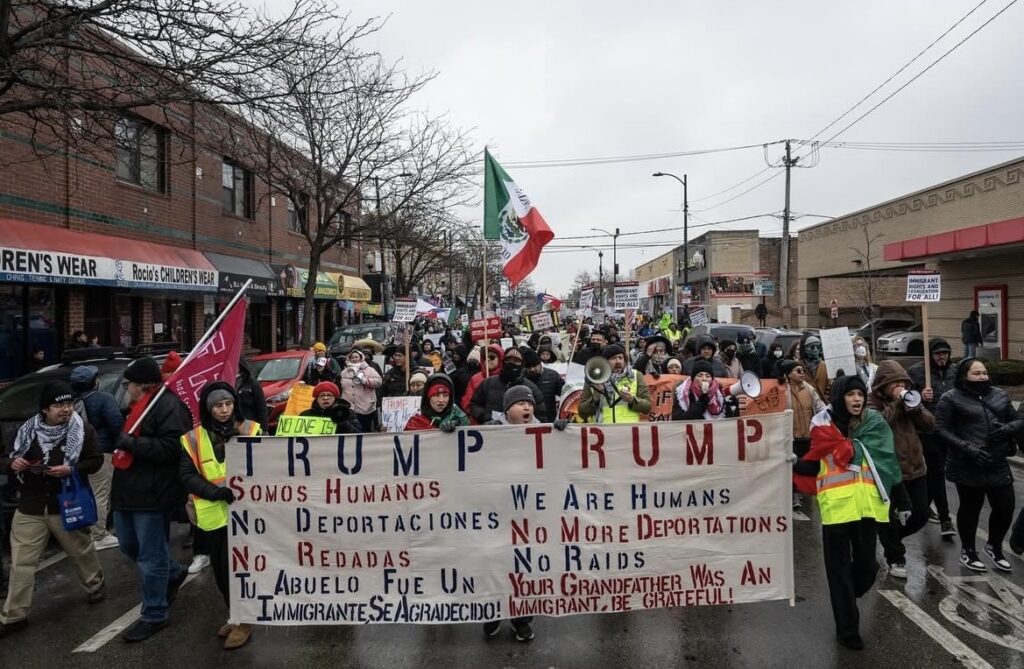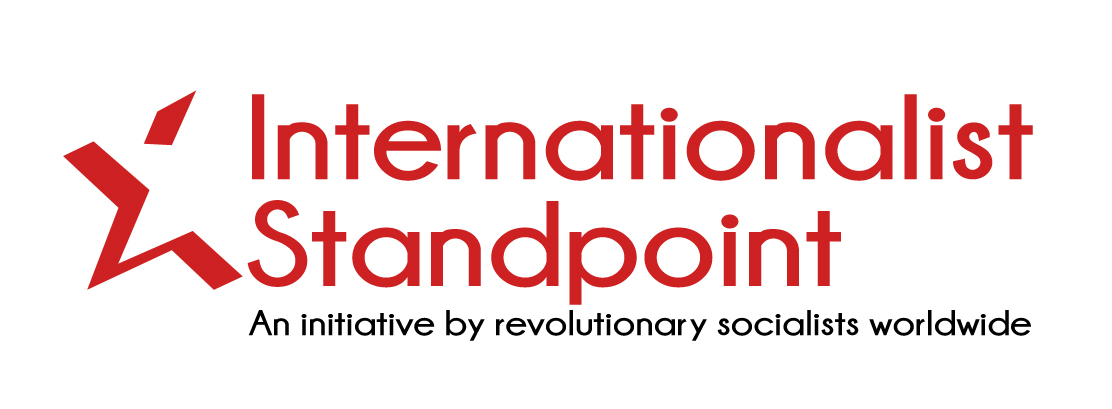By Nick Wozniak and Matt Wylder
Opposition to Trump is intensifying. He has sparked what are likely the largest days of protest in US history: “No Kings,” in June and October.
The President has federal troops terrorizing U.S. cities and makes constant threats of force, but the effect so far has been to galvanize resistance and sink his standing. Neighborhoods and workplaces have mobilized in opposition to ICE raids. His approval ratings are dropping to new lows as anger rises over his economic policies. While the Trump-appointed Supreme Court has shown him great deference, Trump has felt some friction from the courts. The judiciary may throw his signature tariff policy into disarray. Meanwhile, the first electoral referenda on Trump are in: he has suffered blow-out defeats in state elections against the Democratic Party, which itself is historically unpopular.
Trump’s outrageous policies have millions talking about the threat of “fascism” in America. He has shaken American society and the global economy, and it’s not yet clear how far he may go toward authoritarianism. Considering he attempted a violent coup on January 6th, 2021, he may again try to choose an opportune moment to spark a constitutional crisis. Other routes of escalation could be invocation of the Insurrection Act (essentially declaring martial law) or openly defiance of the courts. In spite of resistance, Trump will continue to ramp up ICE terror across the country, and could try to deploy the National Guard or military, pressing the armed forces to pick political loyalties.
This contradictory picture highlights the important momentum of the growing anti-Trump movements, as well as the absence of strategic breakthroughs that could affect stronger defeats against Trumpism, which, as a movement, is trying to cement its position in society and the state.

Pro-Democracy Demands Against Trump
The struggle against Trump’s authoritarian agenda is being conducted in a fight over American symbols of democracy. The No Kings protest on October 18, which attracted an estimated 7 million, was a massive carnival celebrating the democratic traditions of the U.S., attempting to seize the American past away from Trump’s grotesque MAGA nationalism. Among the most common slogans was a reference to the American Revolution: “No Kings since 1776”; protestors waved flags and dressed like the Statue of Liberty.
Meagan Day commented on this symbolic struggle in Jacobin: “It was never a good idea to cede the entire territory of national identity to the Right. … We should stand our ground and fight for those symbols. Our symbols are as mercurial and contradictory as our nation’s history: they can stand for exclusion or inclusion, for domination or equality, for our greatest moral ambitions or our basest impulses and most damning hypocrisies.”
The mass fight against repression is the struggle for the more progressive aspects of American political culture against its worst. Our democratic tradition is the echo, however distant, of the revolutionary cries against the Crown and the slavers. But our heritage is also the Indian Wars, the Confederacy, Hiroshima, Vietnam, the IMF, Iraq, and Gaza. Trump’s authoritarian designs are the domestic expression of an executive power which, since the end of the Second World War, has accumulated more martial power than any office in human history.
America has traditions worth reclaiming: the revolution of 1776, the Civil War, the labor movement, the Civil Rights movement, and the Progressive-era extensions of the Bill of Rights. All were struggles for democracy beyond its current limits. While much of American society today appears defined by counterrevolution against our progressive movements and gross, imperial triumphalism, even mainstream figures and movements in U.S. history refutate Trump’s vision of a white, Christian authoritarianism. Evocations of Anti-Trump patriotism, with all its contradictions, will be a part of the gathering movement of millions to fight back.
It’s too hasty and simplistic to dismiss the No Kings mobilizations as “pro-American” and, therefore, pro-status-quo or reactionary, as do some on the Left. This attitude risks abstaining from a living process. Unlike the mass marches of the first Trump administration, which were dominated by simple calls for a “blue wave” that would sweep away Trump as an aberration, 2025’s mass mobilizations show a new radicalism.
Today’s demonstrators reflect a mass confusion and a desperate urge to understand what the hell is really going on. People, in their millions, are searching American history for examples for how to fight Trumpism, which is recognized as a much deeper problem than before. Instead of simple illusions in the Democrats, protests are dominated by anger at the Democrats for their failures. Demonstrators are consciously aimed at pressing the Democrats to fight harder.
Of course, the Left is absolutely correct to raise warnings and criticism. Diffuse anti-Trump patriotism is ripe for cynical manipulation by the corporate Democratic Party, and is ultimately wrong that the U.S. government has ever been – or could be – fully “of the people.” Nevertheless, No Kings puts the complex developments in American consciousness on display: a mass cross-section of society looking for productive, progressive activism, in many cases for the first time.
Yes, the mass appeal of anti-Trump patriotism is articulating the incredible weakness of working-class politics, but the experience of millions on the streets will open new possibilities for class politics. The Left needs patiently to build – aware that neither the Democrats, nor some restoration of “American values” is enough to address the deep crisis of world capitalism driving Trumpism and its counterparts around the globe. American workers and youth need to relearn the meaning – and power – of class politics.

Dynamics of Struggle
Resistance to Trump is raising an intense discussion about different strategies. In Chicago, the ICE terror campaign has pushed people with no previous activist experience into joining self-defense networks. Every day, communities watch school dismissals and street corners with whistles to alert of ICE’s presence. Activists report their whereabouts on a network of Signal chats, and the bravest block ICE’s movement on the streets. Non-violent resistance trainings are being organized by a host of different organizations. Union teachers are organizing self-defense in the schools. Communities are beginning to get mobilized.
Illinois Democratic Governor J.B. Pritzker is the most powerful figure placing obstacles in Trump’s way. He is caught amidst competing forces: Trump to his right, and street pressure to his left. His strategy ultimately stems from his desire to mediate what he sees as excesses on either side. Pritzker’s mobilization of the State Police to the ICE Detention center in Broadview is a case in point. On the one hand, they limit ICE’s violent repression of protestors. On the other, they undercut the efficacy of the protests, escorting ICE vehicles in and out of the building.
Triangulation by Democratic elites ultimately hopes to push resistance into the courts and towards the midterms. The courts have shown some resilience in the face of Trump – at least in regards to due process issues – and his resistance to the courts has not been as aggressive as it might be. The Democrats’ 2025 election victories hint that they may make further electoral gains in 2026 and 2028. Institutional defeats of Trump provide our movements better terrain, but cannot themselves stave off the enormous growth of Presidential power predating even the PATRIOT Act. To reverse Trumpism and cement new progressive and democracy victories, the cynical designs of the Democratic establishment must also be thwarted.
Democratic Socialism and the Democratic Party that Can’t Stop Capitulating
The Democrats’ balancing act requires them sometimes to discipline the movement and, at others, to encourage. Yet, the current upheaval and intensity of US politics and the scale of political engagement means this dynamic is anything but smooth.
Democratic socialist Zohran Mamdani’s victory in the New York City mayoral election is the most high profile rebuke of the Democratic establishment so far. President Obama’s former campaign manager, David Axelrod, was dismayed that the Mayor-elect’s victory speech offered more of a “closed fist” than “open hands”; that it was “graceless,” not “healing.” Meanwhile The New York Times and New York Governor Kathy Hochul are pressing Mamdani to weaken his demands to tax the rich to fund free buses, and settle for a silly means-tested alternative. So long as Mamdani adheres to his basic demands and solidarity with Palestine, his mayoralty will spotlight the enormous friction and contradiction between many Democratic voters and the party’s establishment.
Mamdani is also further mainstreaming the “democratic socialist” label within the Democratic party. Days after his victory, a democratic socialist was confirmed to be the winner of Seattle’s mayoral election. Katie Wilson and her campaign talked about being a socialist far less than Mamdani’s, but she has been introduced by all major media as aligning with the movement. Meanwhile, thousands of new members have joined the Democratic Socialists of America (DSA) since Mamdani’s election. Marxists should be seeking to participate in this challenge against the Democratic establishment and need to struggle to find the right tactics without abandoning core principles. The first step would be to join DSA and participate in building it and connecting it to united front struggles.
Meanwhile, the fight over the shutdown of the federal government from October through November demonstrated the concessions forced upon the Democrats by mass, public anger. In February, the Democrats refused to fight Trump through a shutdown, and Democratic Senate Leader Chuck Schumer was roundly mocked as pathetic. The willingness of the Democrats to hold out this time was a concession to the total rage of much of the electorate. Even 44% of self-identified “MAGA supporters” support the Democrats’ shutdown demand to extend ACA funding.
On November 9, Eight Democratic Senators joined Republicans to end the shutdown, sparking even more anger and blowing much of the goodwill they had fostered in the November election just days before. Popular, left-liberal talk show host Jon Stewart slammed Democrats saying, “they fucking caved.” Some Democratic officials have begun to demand Schumer step down as Senate caucus leader.
The working class needs to take center stage as an independent force in the struggle for democracy and against austerity. Though the Democrats are forced to respond to mass pressure, their politics are intended to weaken and divert resistance into simple electoralism. Mass disruption to harm corporate profits is the necessary, next tactical step for the mass movement. A coordinated and militant movement with its own independent strategy on the streets, in our unions, and in the communities is our best weapon to defend and extend democracy, fight austerity and for a real fightback.
Our movement should be applying civil disobedience tactics practiced during the 1960’s Civil Rights movement, the kind of tactics on which Pritzker’s state police are cracking down. Critically, it’s important that new independent organizations are crystallized out of the movement, or else it may fast evaporate or be “safely” channeled by the Democrats. If new, grassroots and independent organizations are formed, they could be the vehicles for class-struggle ideas to spread much further.

Mass Strikes & Disruptive Actions Needed
Our strongest weapon against Trump would be mass, political strikes to weaken and cripple his regime. Mass strikes can’t guarantee immediate results; Trump would surely fight back. Yet, strikes would inflict serious blows to the confidence of the ruling class and educate workers about the power they hold. Such strikes can’t be called with the snap of the fingers. It requires serious, militant preparation.
Strikes can bridge street demonstrations to a serious struggle against Trump’s class war on workers. Worker struggle is currently running mostly in parallel to the mass movement, rather than being strongly interconnected. We need Starbucks workers, autoworkers, educators, nurses, farmworkers, carpenters, and electricians united for a better world. A united working class has the power to shut down the entire economy, and Trump’s regime would be given no room to breathe.
That being said, an enormous weakness of the U.S. situation is the union leaders’ criminal abdication in the face of Trump’s all-out assault on workers rights, their unions, and any new organizing. United Auto Worker President Shawn Fain’s call for a general strike in 2028 is the exception that proves the rule. Unfortunately, the lack of serious preparation by even progressive, major unions for this far off date underlines the pitiful cowering from the existential fight posed by Trump.
In the recent government shutdown fight, Everrett Kelley, leader of the American Federal Government Employees (AFGE), not only did not contemplate worker action against Trump’s cuts – he buckled a short way into the fight and sided with Trump to reopen the government! With a re-opened government, beleaguered federal workers can get the paychecks they are due. Yet, Kelley has turned his back on millions who will now face skyrocketing health care costs, wasting an opportune moment to unite these struggles and truly embarrass Trump. Now Trump will be able to get back to business as usual, which includes trying to completely destroy AFGE! Workers cannot win without fighting with the slogan “an injury to one, is an injury to all.”
These shocking capitulations by union leaders are indicative of the profound rot that exists at the top of the national labor movement. Labor misleadership dangerously empowers Trump and exposes the official union movement to being virtually crushed. Pro-Trump Teamsters President Sean O’Brien has actively tried to amplify class, immigration status, and identity divisions among workers in an attempt to win special treatment for his union from the right wing and capitalist class. O’Brien’s class-traitor policy is without any tangible results, yet his weight in the movement speaks to the uphill battle ahead for real working-class politics of solidarity and struggle.
The socialist and labor left cannot wait around. We need united front tactics that advance politicized workplace actions that set examples and popularize open conflict with the Trump regime. Crises in unions like AFGE are throwing forward new rank-and-file initiatives like the Federal Workers Union Network (FUN). There is enormous work to be done. However, historically the labor movement has not been built or rebuilt through a slow, gradual process of orderly accumulation. Periods of crisis, with millions moving into action, offer new hope for a radical shake up of labor, despite the gloom that hangs around the official movement.
- Mobilize to confront state forces and their repression everywhere they go!
- Learn the lesson of past resistance – direct action and mass demonstrations must lead activists to build new, independent organizations that continue the struggle for the long haul.
- The socialist and labor left must work together in the labor movement to advocate mass strike action against austerity and authoritarianism.
- The labor left needs to recognize the absolute self-destructiveness of capitulations to Trump by labor leaders like Kelley in the AFGE on one side, and the class traitorism of O’Brien in the Teamsters on the other.
- Mass strikes must build the bridge between democratic demands, economic demands, and the demand for citizenship for the undocumented!
- We believe the fight against the Democratic establishment should lead to a new working-class party rooted in a revived socialist and labor movement.



